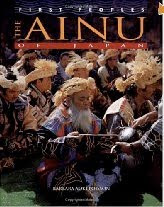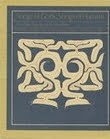
Iyomante~Meguru inochi no okurimono (Iyomante, the gift of the cycle of life) is illustrated by Toshiya Kobayashi, a prolific and award-winning artist better known for his series of books (numbering over 15) illustrating the fantastical tales of Kenji Miyazawa, the nearly legendary storyteller and social activist of the early 1900s. In Iyomante, Kobayashi's illustrations provide a window into the daily life and rituals of the Ainu people beyond what is directly mentioned in author Michico Ryo's text. The illustration I posted in the previous blog pictures a mustache-like tattoo around the mother's mouth, though this custom is not mentioned in the text. The tattooing process began when the girl was twelve or thirteen, and was usually completed by the time she was fifteen or sixteen, at which point she was considered eligible for marriage. Notice the earrings and choker she wears. There are carefully preserved samples of these adornments in Ainu museums. The illustration I posted today shows village elders gathered around a fireplace, preparing for the bear-sending ceremony by offering droplets of wine to the hearth fire god from ornately carved prayer sticks dipped into lacquered bowls of wine. You can see how the elders are dressed for the occasion, particularly the headgear woven from straw. They are surrounded by the food and decorated willow sticks that have been made ready as gifts for the bear to take back with him to the land of the gods. The window at the top of the illustration is the "sacred window," always located on the eastern side of a dwelling, and through which the gods were thought to enter and leave the home. I could go on and on explaining what is represented in this illustration alone! The thought and research that went into each illustration in this storybook boggles the mind.










